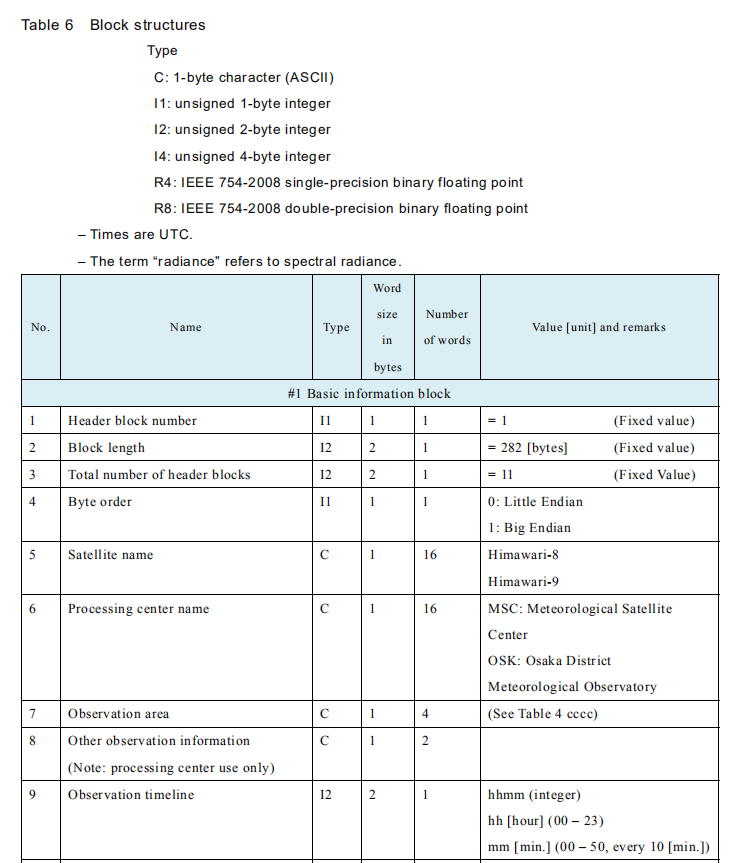Himawari-8 HSD数据解析及辐射定标
Himawari-8 HSD数据解析及辐射定标
1. HSD数据结构介绍
## Full-disk
HS_H08_YYYYMMDD_hhmm_Bbb_FLDK_Rjj_Skkll.DAT
where YYYY: 4-digit year of observation start time (timeline);
MM: 2-digit month of timeline;
DD: 2-digit day of timeline;
hh: 2-digit hour of timeline;
mm: 2-gidit minutes of timeline;
bb: 2-digit band number (varies from "01" to "16");
jj: spatial resolution ("05": 0.5km, "10": 1.0km, "20": 2.0km);
kk: segment number (varies from "01" to "10"); and
ll: total number of segments (fixed to "10").
example: HS_H08_20150728_2200_B01_FLDK_R10_S0110.DAT
具体命名格式如上,其中需要注意的是kk代表segment number,一开始笔者不明其意,下载了单景分辨率1km的全圆盘影像,发现行列号为(1100*11000),于是很纳闷为啥圆盘是这么个长方形。思索了很长时间没有结果,于是休息了一会,今天突然发现了原因:segement number编号为01-10,其实是将(11000 * 11000)的圆盘图像分割成了10个小图像!!!

于是立刻编写代码验证想法,一经测试果真如此,下图为数据合成后的结果。

2. DAT文件的读取
了解了Himawari-8 hsd数据的格式后,就可以开始读取每个DAT文件了。下面这个链接给出了DAT文件的数据格式及其python读取方法,其中将DAT文件按一定format读取,转换成了可以打开的txt。
DAT数据由12个block组成,每个block有自己的组织形式,如下图。


读取方法如下:1. 对于数据量小的数据可以用f.read()逐字读取
2. 对于数据量大的数据用`np.fromfile()`配合**format**读取
3. 其实不用`f.seek()`也可以用`re`匹配
4. `pandas.read_table()`也可以读取.dat
5. **辐射定标**:可在DAT文件中读取定标系数,进行辐射定标;此外**Albedo/Tbb的反射率定标方法有所不同**。
def read_hsd(inputfile):
'''
@desc: 打开单个segment图幅,读取.DAT文件中的信息(data/gains/bias...)
@method: np.fromfile()
'''
resolution = int(inputfile[-12:-10])
if resolution == 10:
rows = 1100
cols = 11000
elif resolution == 20:
rows = 550
cols = 5500
else:
rows = 2200
cols = 22000
# 打开文件
f = open(inputfile, 'rb')
# 获取Observation start time
f.seek(46)
imgtime = struct.unpack('d', f.read(8))[0]
# 获取Total header length
f.seek(70)
header_length = struct.unpack('i', f.read(4))[0]
# 获取影像
formation = [('header', 'S1', header_length), ('pixel', 'i2', rows*cols)]
imgdata = np.fromfile(inputfile, dtype=formation)['pixel'].reshape(rows, cols)
'''
@desc: 下面是辐射定标部分,如果不需要可省略
'''
# if resolution != 20:
# # 重采样至550行,5500列,可省略
# imgdata = imgdata.reshape(550, int(20/resolution), 5500, int(20/resolution)).mean(axis=(1, 3))
# 获取Sun's position
f.seek(510)
sun_pos1 = struct.unpack('d', f.read(8))[0]
# print(sun_pos1)
f.seek(510+8)
sun_pos2 = struct.unpack('d', f.read(8))[0]
# print(sun_pos2)
f.seek(510+8+8)
sun_pos3 = struct.unpack('d', f.read(8))[0]
# print(sun_pos3)
# 获取Band number
f.seek(601)
band_num = int.from_bytes(f.read(2), byteorder='little', signed=False)
# 获取Gain
f.seek(617)
Gain = struct.unpack('d', f.read(8))[0]
# print(Gain)
# 获取Offset
f.seek(625)
Offset = struct.unpack('d', f.read(8))[0]
# print(Offset)
# 计算radiance
radiance = imgdata*Gain + Offset
# print(radiance[0][1580])
# 对前6波段定标成反射率
if band_num <= 6:
# 获取radiance to albedo
f.seek(633)
cc = struct.unpack('d', f.read(8))[0]
f.close
# 计算反射率
albedo = radiance * cc
outdata = albedo
# 后面的波段定标成计算亮温
else:
# 获取Central wave length
f.seek(603)
wv = struct.unpack('d', f.read(8))[0]
# 获取radiance to brightness temperature(c0)
f.seek(633)
c0 = struct.unpack('d', f.read(8))[0]
# 获取radiance to brightness temperature(c1)
f.seek(641)
c1 = struct.unpack('d', f.read(8))[0]
# 获取radiance to brightness temperature(c2)
f.seek(649)
c2 = struct.unpack('d', f.read(8))[0]
# 获取Speed of light(c)
f.seek(681)
c = struct.unpack('d', f.read(8))[0]
# 获取Planck constant(h)
f.seek(689)
h = struct.unpack('d', f.read(8))[0]
# 获取Boltzmann constant(k)
f.seek(697)
k = struct.unpack('d', f.read(8))[0]
f.close
# 计算亮温
wv = wv * 1e-6
rad = radiance * 1e6
Te = h*c/k/wv/(np.log(2*h*c*c/((wv**5)*rad)+1))
BT = c0 + c1 * Te + c2 * Te * Te
# 返回值
outdata = BT
# 返回:albedo / BT, 时间, 太阳坐标
sunpos = [sun_pos1, sun_pos2, sun_pos3]
out = {'pixels': list(outdata.flatten()), 'time': imgtime, 'sun_pos': sunpos}
return out
3. 经纬度和行列号互转
与FY-4A类似,Full-disk数据在几何校正的时候都需要进行经纬度与行列号的转换,从而把NOM投影转换成等经纬度投影。两者计算的唯一差别在于卫星星下点经纬度、行偏移、列偏移的不同(COFF/LFAC...),其他公式都一样。
下面给出经纬度与行列号的转换代码:
def calParameter(resolution):
'''
@desc: 计算Himawari-8 COFF/CFAC/LOFF/LFAC
@resolution: 10:1km/20:2km
'''
if resolution == 20:
row = 550
col = 5500
COFF = LOFF = 2750.5
CFAC = LFAC = 20466275
elif resolution == 10:
row = 1100
col = 11000
COFF = LOFF = 5500.5
CFAC = LFAC = 40932549
return COFF, LOFF, CFAC, LFAC
def latlon2linecolumn(lat, lon, resolution):
"""
经纬度转行列
(lat, lon) → (line, column)
resolution:文件名中的分辨率
line, column
"""
COFF, LOFF, CFAC, LFAC = calParameter(resolution)
ea = 6378.137 # 地球的半长轴[km]
eb = 6356.7523 # 地球的短半轴[km]
h = 42164 # 地心到卫星质心的距离[km]
λD = np.deg2rad(140.7) # 卫星星下点所在经度
# Step1.检查地理经纬度
# Step2.将地理经纬度的角度表示转化为弧度表示
lat = np.deg2rad(lat)
lon = np.deg2rad(lon)
# Step3.将地理经纬度转化成地心经纬度
eb2_ea2 = eb ** 2 / ea ** 2
λe = lon
φe = np.arctan(eb2_ea2 * np.tan(lat))
# Step4.求Re
cosφe = np.cos(φe)
re = eb / np.sqrt(1 - (1 - eb2_ea2) * cosφe ** 2)
# Step5.求r1,r2,r3
λe_λD = λe - λD
r1 = h - re * cosφe * np.cos(λe_λD)
r2 = -re * cosφe * np.sin(λe_λD)
r3 = re * np.sin(φe)
# Step6.求rn,x,y
rn = np.sqrt(r1 ** 2 + r2 ** 2 + r3 ** 2)
x = np.rad2deg(np.arctan(-r2 / r1))
y = np.rad2deg(np.arcsin(-r3 / rn))
# Step7.求c,l
column = COFF + x * 2 ** -16 * CFAC
line = LOFF + y * 2 ** -16 * LFAC
return np.rint(line).astype(np.uint16), np.rint(column).astype(np.uint16)
4. 几何校正
最后就是进行几何校正了,需要我们设定目标区的经纬度范围(如Lon: 90-120 Lat: 30-50),然后根据pixelSize计算出geotrans、col/row等信息。最后根据经纬度反算出行列号,进而求得行列号对应的像元的值,写入数组,这样就完成了几何校正。
-
切记行列号顺序不可弄错,numpy先行后列,gdal先列后行。

def hsd2tif(arr, lonMin, lonMax, latMin, latMax, pixelSize, file_out):
'''
@desc: 几何校正,输出tif
'''
col = np.ceil(lonMax-lonMin)/pixelSize
row = np.ceil(latMax-latMin)/pixelSize
col = int(col)
row = int(row)
xnew = np.linspace(latMin, latMax, row)
ynew = np.linspace(lonMin, lonMax, col)
xnew, ynew = np.meshgrid(xnew, ynew)
dataGrid = np.zeros((row, col)) # numpy数组先行后列!!!
index = {}
for i in tqdm(range(row)):
for j in tqdm(range(col)):
lat = xnew[i][j]
lon = ynew[i][j]
h8Row = 0
h8Col = 0
if index.get((lat, lon)) == None:
h8Row, h8Col = latlon2linecolumn(lat, lon, 10)
index[(lat, lon)] = h8Row, h8Col
else:
h8Row, h8Col = index.get((lat, lon))
if (0<=h8Row<11000) and (0<=h8Col<11000):
dataGrid[i][j] = arr[h8Row, h8Col]
print("Worked!" + str(dataGrid[i][j]))
else:
print("该坐标(%s, %s)不在影像中"%(lon, lat))
geotrans = (lonMin, pixelSize, 0, latMax, 0, -pixelSize)
srs = osr.SpatialReference()
srs.ImportFromEPSG(4326)
proj = srs.ExportToWkt()
raster2tif(dataGrid, geotrans, proj, file_out)
5. 后记
到这里我们的HSD数据解析和辐射定标就完成了。
-
后续还可以调用6S模型进行大气校正,这也需要更多的地理信息如(SALA/SAZA/SOLA/SOZA),https://blog.csdn.net/qq_33339770/article/details/103023725 这里给出了一些参数的计算方法。
-
根据经纬度反算行列号,计算速度偏慢。
如果需要快速出图的话,建议使用已经计算好的经纬度栅格图进行GLT校正,速度会快很多。(ENVI有GLT校正模块,gdal应该也有,后续可以建立好经纬度栅格图然后调用gdal来批量几何校正)





